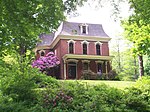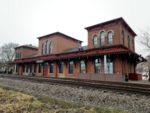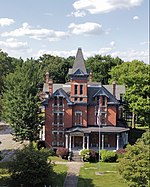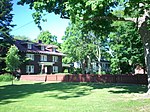Theodore Roosevelt High School (Kent, Ohio)

Theodore Roosevelt High School (RHS or TRHS), often referred to as Kent Roosevelt (KRHS), is a public high school in Kent, Ohio, United States. It is the only high school in Kent and the Kent City School District and serves students in grades 9–12 living in Kent, Franklin Township, Brady Lake, and Sugar Bush Knolls as well as a small portion of southern Streetsboro. As of the 2021–22 academic year, enrollment was 1,267 students with 73 teachers for a student–teacher ratio of 17:1. Recognition for academic performance over the years has come from the United States Department of Education, Ohio Department of Education, and U.S. News & World Report. The school was founded in 1868 as Kent High School and was first housed at the Franklin Township Hall until the completion of the Union School building in March 1869. In 1922, the school was moved to a new facility named for U.S. President Theodore Roosevelt on a 10-acre (4.0 ha) campus, which would serve as the high school until 1959. Following completion of a new building on a larger 31-acre (13 ha) campus along North Mantua Street in northern Kent, Roosevelt was moved to this location. The building has had a number of additions made beginning in the mid-1960s and contains nearly 70 classrooms, a library, two gymnasiums, auditorium, and indoor pool. The campus has been expanded over the years to 90.5 acres (36.6 ha) and also includes several athletic facilities and practice fields, and Stanton Middle School. Nearly 200 courses are offered at the school including 13 Advanced Placement classes and 25 vocational education programs. Roosevelt is part of the Six District Educational Compact which pools vocational resources with five nearby high schools. There are also two academy programs for students with various educational needs. Other elective courses offered include those in the study Arabic language, lifeguard training, various aspects of American history and culture, multiple writing and journalism courses, and the visual, performing, and practical arts. There are multiple co- and extracurricular clubs and activities, many of which have earned outside recognition at the state and national levels. Roosevelt athletic teams are known as the Rough Riders with school colors of red, white, and black, and compete in the Suburban League American Division as part of the Ohio High School Athletic Association. Notable Roosevelt alumni include a Governor of Ohio, professional athletes, and entertainment figures.
Excerpt from the Wikipedia article Theodore Roosevelt High School (Kent, Ohio) (License: CC BY-SA 3.0, Authors, Images).Theodore Roosevelt High School (Kent, Ohio)
North Mantua Street, Kent
Geographical coordinates (GPS) Address Nearby Places Show on map
Geographical coordinates (GPS)
| Latitude | Longitude |
|---|---|
| N 41.168880555556 ° | E -81.356152777778 ° |
Address
North Mantua Street 1400
44240 Kent
Ohio, United States
Open on Google Maps








